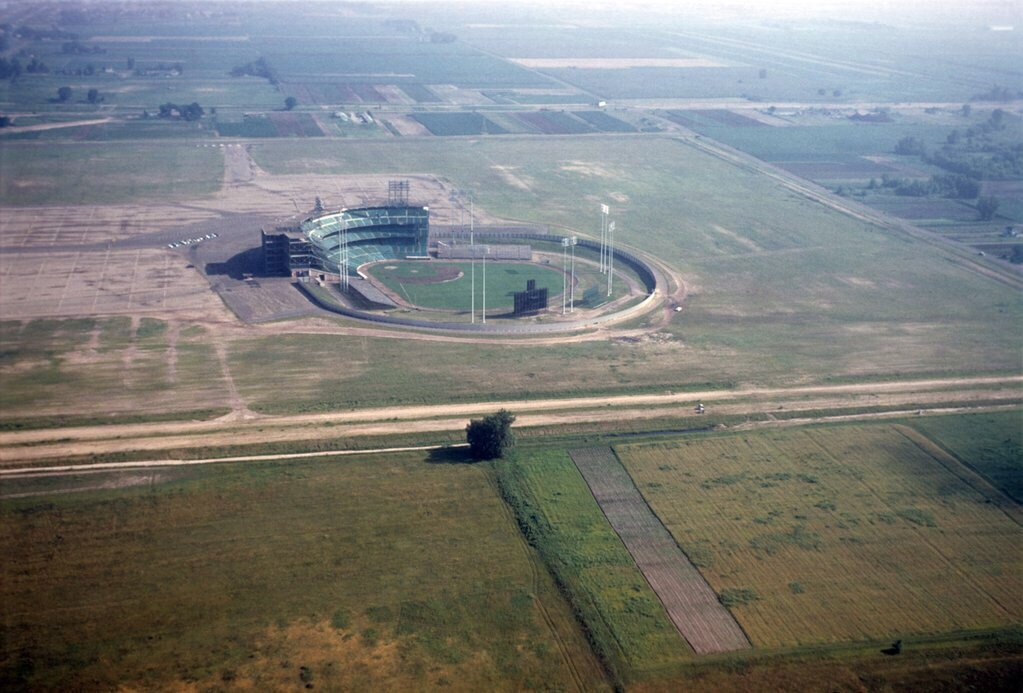If you’re one of the tens of thousands of shoppers visiting the Mall of America this holiday season, take a moment to remember what originally stood on the site: Metropolitan Stadium, the first home of the Minnesota Twins.
Metropolitan Stadium was unveiled on April 24, 1956 as the home of the Class AAA Minneapolis Millers of the American Association, but it was never built to be only a minor-league stadium: It was built to attract big-league ball. It was a unique stadium at the time. The main three-decked grandstand was complete and wrapped from third base to first, but there were only temporary bleachers down the third-base line and fences in the outfield. (It was also in the middle of nowhere, as shown by the above photo.) But it did attract the attention of the likes of Bill Veeck, Nate Dolan and Horace Stoneham, all of whom considered moving their team to the Minneapolis suburbs. Max Winter, who later owned the NFL’s Minnesota Vikings, was tabbed to own a potential Continental League team.
It was a time when Minneapolis-St. Paul leaders felt the need to enter the big leagues, a time of growth and optimism in the Twin Cities. The Met was the initiative of the area’s business leaders, aided by the powerful Minneapolis Tribune. When Calvin Griffith agreed to move his Washington Senators to the Met for the 1961 season, all that wooing of MLB owners paid off, and part of the commitment to Griffith was to expand the Met to MLB standards in terms of seating.
Architecturally speaking, the Met was a mess, with much of it due to the way the Met was expanded: piecemeal. The grandstand would be extended down to the outfield when the Twins moved in 1961, and in 1965 the left-field pavilion was built by the NFL’s Minnesota Vikings. At the time, its cantilevered design was considered revolutionary, with no poles or pillars to obstruct any views. But the thrifty expansion came at a price: Each of the seating areas had its own entrance, and you couldn’t just wander the ballpark as you can in today’s more modern baseball palaces. It was the byproduct of an area that sought to cram as many bodies in the ballpark in an efficient manner.
Those Minnesota Twins of the 1960s and 1970s certainly were entertaining, with the likes of Harmon Killebrew, Bob Allison, Rod Carew, Mudcat Grant and Tony Oliva wowing a generation of baseball fans. The team made the 1965 World Series, losing to the Los Angeles Dodgers, and won divisional titles in 1969 and 1970. By 1981, the Met was falling apart—literally—and the final Twins game played at the Met was on Sept. 30, 1981, with the Metrodome opening for the 1982 season. The ballpark then fell into disrepair before being torn down to make way for the Mall of America, which opened in 1992.
For a ballpark generating so many memories for a generation of Minnesotans, there are few reminders of the Met’s legacy at today’s Mall of America. Killebrew Drive runs on the south side of MOA, and inside the Mall there are only two physical reminders of the Met, both in the Nickelodeon Universe amusement-park area. The original home-plate location is commemorated by a plate marker next to the Pineapple Poppers SpongeBob SquarePants bouncy house and a roller coaster. A red ballpark seat sits on the opposite side of the mall, mounted above a flume ride. This marks the landing spot of the longest home run in the Met’s history, a 520-foot blast from Killebrew, the “aw-shucks” slugger from Idaho. That’s it. It could be worse: there are no physical reminders of the Minnesota Vikings and the great Bud Grant teams of the 1960s and 1970s.
Take in a Twins game at Target Field, and you will see a few more reminders of the Met, starting with the exterior statues of Killebrew and Carew. The Metropolitan Club, limited to season-ticket holders after Target Field opened, featured plenty of historical displays honoring the Met. But the Metropolitan Club is undergoing renovations this offseason to a social space open to all, and we’re assuming some of those Met displays will live on in the new facility. The one other direct link to the Met: the original Met Stadium flagpole is installed at Target Field, albeit in a scaled-down form. When the Met closed, a local American Legion post purchased the 100-foot flagpole and installed it at the Legion. It stood there until 2009, when the Twins agreed to donate $10,000 to the Legion team and buy a replacement flagpole in exchange for the historic artifact. After a cleaning and a repainting, the flagpole was cut down to 45 feet and installed behind the right-field seating, on Target Plaza.
This article first appeared in the weekly Ballpark Digest newsletter. Are you a subscriber? It’s free, and you’ll see features like this before they appear on the Web. Go here to subscribe to the Ballpark Digest newsletter.
Previous Ballparks That Live on Entries:




